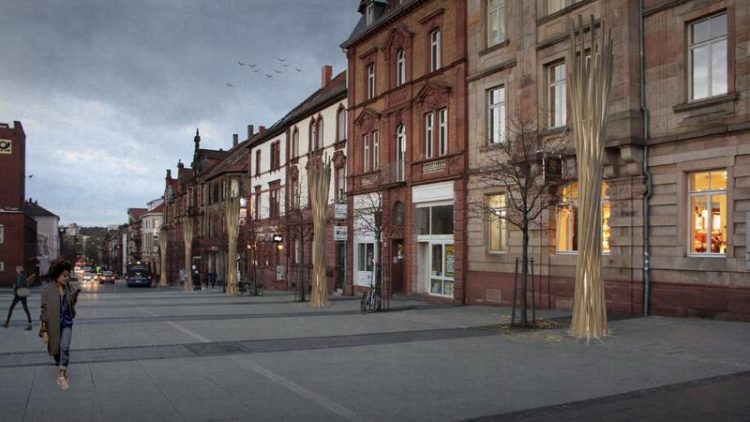IFA 2019: Architects develop 5G transmission masts made of wood for a sustainable city image

In a seminar held in the Department of Architecture at Technische Universität Kaiserslautern, participants discussed the possible design of 5G transmission masts. Credit: AG Robeller/TUK
Downloading a video on your smartphone at lightning speed or watching a football match on it without any time delay – this too should be possible in the future with 5G technology. However, in order to ensure secure and reliable data transmission, 5G transmission masts have to be distributed throughout the entire area.
This will also have an impact on the city image. Student teams at TU Kaiserslautern have dealt with this topic during a seminar with junior professor Dr Christopher Robeller and developed corresponding models for 5G base stations.
“And for those masts, they used the material wood,” explains the junior professor, who heads the Digital Timber Construction working group at TUK. “Cities still have to find out how the new technology can best be integrated into the city image,” continues the architect from Kaiserslautern.
There are several reasons why this natural material is an ideal product. “The production of such stations, for example, would produce little or no CO2,” he adds.
For their designs, the student teams also took an aesthetic city image into account: The technology is cleverly hidden. “These smart masts could be used at many locations, such as intersections,” says Robeller. “Here they can also include other sensors of a Smart City, for example for intelligent traffic control.”
The three best designs of the seminar are currently being used to build models. The architects from Kaiserslautern work closely together with the Finnish company Ecotelligent Ltd. This company specialises in developing and building environmentally friendly wooden telecommunication masts and systems.
These smart masts will then be installed as part of a pilot project in Kaiserslautern. Therefore the team around Robeller and Ecotelligent cooperates with KL.digital GmbH, the digitisation agency of the city of Kaiserslautern. Citizens are asked to choose the best model. If the masts meet expectations, it is possible to use them in other cities throughout the globe in the future.
The research area “T-Lab Wood Architecture and Wood-Based Panels” at TU Kaiserslautern is a competence centre for wood. The architects are working on new construction methods, techniques and structures and on how wood can be used to a greater extent in the construction industry in the future. New digital technologies also play an important role here. The area of research is located at the interface of architecture, computer science, civil engineering and manufacturing technology.
At IFA, the architects will be presenting their work at the joint stand of the Working Committee for Science Marketing on fairs in the “IFA Next” area.
Jun. Prof. Dr Christopher Robeller
Digital Timber Construction DTC
Phone:: +49 631 205-2293
E-mail: christopher.robeller(at)architektur.uni-kl.de
Media Contact
More Information:
http://www.uni-kl.deAll latest news from the category: Trade Fair News
Newest articles

Superradiant atoms could push the boundaries of how precisely time can be measured
Superradiant atoms can help us measure time more precisely than ever. In a new study, researchers from the University of Copenhagen present a new method for measuring the time interval,…

Ion thermoelectric conversion devices for near room temperature
The electrode sheet of the thermoelectric device consists of ionic hydrogel, which is sandwiched between the electrodes to form, and the Prussian blue on the electrode undergoes a redox reaction…

Zap Energy achieves 37-million-degree temperatures in a compact device
New publication reports record electron temperatures for a small-scale, sheared-flow-stabilized Z-pinch fusion device. In the nine decades since humans first produced fusion reactions, only a few fusion technologies have demonstrated…





















